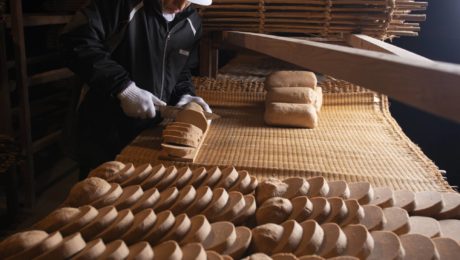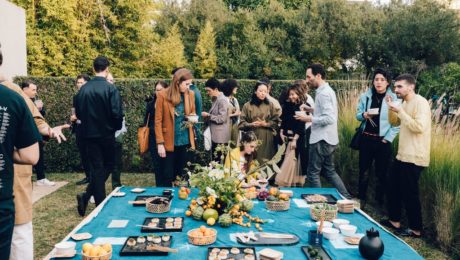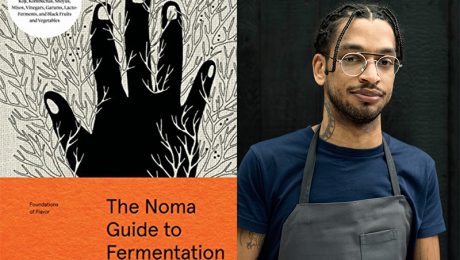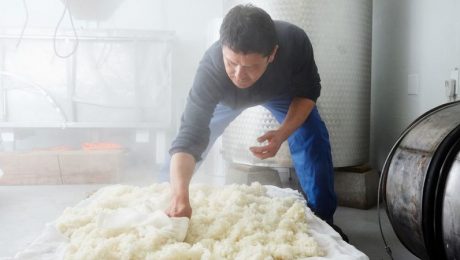170-year-old Miso Brand Ferments with Koji in Straw Mats
Miura Fermented Food’s in Japan takes unique steps to make miso. Making miso since 1849, Miura creates a nesashi miso, a variety produced with only fermented soybeans. The locally grown soybeans are steamed in large wooden tubs (called koshiki), then ground and shaped into oblong cakes (namako). When the cakes have cooled, they’re sliced into rounds and placed on straw mats. At this point, traditional miso would be sprinkled with koji mold. But Mirua’s miso is fermented through koji in the straw mat.
Fifth-generation owner, Seiji Miura, describes it: “We just let our miso ferment through the action of the koji present in the straw matting as well as in the storehouse.” The microbes “thrive on the moisture of the sliced miso cakes,” Japan Times notes, and after 40-60 days, the cakes are hard and black and covered in a hairy, white mold. Water and salt is then stirred in with the cakes, this mixture is packed into cedar tubs and left to age for three years.
Miura describes nesashi miso as “similar in character to blue cheese. Just a tiny dab adds surprising depth to a dish’s flavor, and it has sparked interest among chocolatiers and chefs who specialize in French or Italian cuisine.”
Read more (Japan Times)
- Published in Food & Flavor
Koji: Learning to Love Mold
What’s the difference between the fuzzy mold that grows on leftovers forgotten in the fridge and the mold koji that creates the umami-rich flavors soy sauce and miso? Controlled growth.
“That’s an important parallel,” says Rich Shih, the koji guru behind Our Cook Quest and co-author with Jeremy Umansky of the book “Koji Alchemy.” Shih spoke during a recent webinar hosted by The Fermentation Association, “Demystifying Fermentation — Learning to Love Mold.” “You create these very specific conditions where the components are food safe…they’re made in a fully controlled, clean environment…when you allow it to go through a fermentation process, it ends up being preserved in a way that is delicious and nutritious for us. That’s the key to fermentation in general. What’s nutritious and delicious to us is a result of these microbes that we persuade in this specific direction to create a circumstance that’s pleasing to us.”
Koji is also known by its scientific name, aspergillus oryzae. Incubating it, Shih says, creates a “blank slate” for the koji spores. He compares it to adding yeast to a bread or beer.
“We’re basically leveraging their ability to be able to do this work on an exponential basis to yield something for us because they’re trying to survive based on the food stuff we give them,” Shih says, explaining the koji fermentation process. “But we’re introducing them to this pool of wonderful, delicious things that they get to convert — and then we take the benefits.”
More chefs are experimenting with koji as a seasoning or marinade. It is empowering and easy to incorporate into dishes, Shih adds, noting: “Once people realize this, koji is really going to explode.” He recommends beginners start with a koji paste.
Alex Lewin, moderator of the webinar, author of fermentation books and TFA Advisory Board member, agrees. He compares koji to the medieval alchemy of the philosopher’s stone, which could transform lead into gold. Koji mold is transforming ingredients into flavorsome food.
“Where bacteria and yeast are very specific and narrow in focus, koji and mold in general have a much broader set of capabilities,” Lewin adds.
Shih shared one of his latest koji kitchen experiments: a cucumber sorbet. He added koji spores to the cucumber, then froze it for a texture similar to shaved ice. He stressed koji “can be a seasoning for any food, regardless of preparation, locale or cuisine. It’s easily translated.”
“Koji, basically it’s magic,” Shih says. “It really changes the game overnight in terms of the flavors you get out of it. It opens a whole world of possibilities.”
Most people are familiar with koji and don’t even know it, Shih says. Koji is an ingredient in soy sauce, a common condiment in home pantries. There’s a huge commercial industry for soy sauce. But Shih says people should learn to experiment with koji outside of a soy sauce bottle. He points to artisan cooks and chefs, who take control of their food by sourcing ingredients from local farms. By fermenting them, they create nutrient-dense food with a long shelf life.
“That’s the gap we fermenters are encouraging people to bridge. You have the power to create nutrition in a way that you enjoy ingredients in your locale,” Shih says. Follow some simple rules with koji and “it’s really hard not to make it taste good. If you know how to boil water and mix things, you can make something super delicious, and that’s empowering.”
- Published in Food & Flavor, Health
Historic LA Home Becomes Experimental Fermentation Kitchen
A historic home in Los Angels is now an experimental kitchen, highlighting fermentation, art and design. The Schindler House hosted an event last month featuring a fermentation-based installation. Stone vessels were filled “with different combinations of soybeans, koji, barley, brown rice, citrus, salt and microbes. Several months later, the altered (mushier) contents of the containers, which had sat in the outdoor hearth of one of the house’s courtyard’s, became key ingredients in an afternoon that was part art happening and part cocktail party.” From the New York Times article: “Over the past decade, chefs and diners have been drawn to all manner of fermented produce, as well as to fermented staples like kombucha and kimchi, sourdough and cider, for their tangy flavors and presumed digestive health benefits. Perhaps surprisingly, so have artists, though for their own reasons. ”
Read more (New York Times)
- Published in Food & Flavor
“As the Fermenter, You’re Kind of the Bouncer Outside of the Nightclub,” David Zilber (Noma)
The creative genius behind Noma’s Fermentation Lab, David Zilber says one of the best parts of fermenting is “to get very nerdy and go really deep and taste the whole Patheon of flavors that the microbial world produces.”
Zilber, author of “The Noma Guide to Fermentation” with Noma founder René Redzepi, spoke to Science Friday about his extensive knowledge of the food science craft. When Zilber started at Noma in 2014, he had extensive experience working in high-end restaurants. He had made kimchi working in an Asian restaurant and cooked with amazing soy sauce imported from Japan, but he never gave a second thought as to where the ingredients came from. At Noma, Redzepi noticed Zilber “had a knack for science…I was usually the gut that had the far too detailed answer,” Zilber says laughing as he describes answering colleague’s food questions. Redzepi movied Zilber to the fermentation lab, a world-famous lab that has helped secure Noma’s Michelin ranking as the 2nd best restaurant in the world.
In the radio interview, Zilber details the fermenter’s roll as a scientist, gives advice on preventing mold and shares why he thinks everyone should have a koji started on their counter. Below are highlights from Zilber’s interview with Science Friday host, Ira Flatow.
What is fermentation?
Zilber: The most succinct way I can define fermentation, in Layman’s term, is it’s the transformation of one ingredient into another by way of a microbe. If you imagine you start out with cabbage, then you get lactic acid bacteria to grow in and alongside your cabbage, in two or three week’s time, you end up with sauerkraut. It’s not the same as it was going in. You’ve cultivated — cultured really — this microorganism in your container with your cabbage. And low and behold, this transformation has taken place.
The Noma book says there’s a fine line between rot and fermentation.
Zilber: The rest of the analogy is that, as a fermenter, there’s actually three people in play in the definition of fermentation: the ingredients, the vegetables or the food stuff, the microbes, but also the person whose acting on that situation and actually wiling the ferment into existence. As the fermenter, you’re kind of the bouncer outside of the nightclub. The guy with the velvet rope, the big muscly dude, and you’re deciding who gets into the club and makes a great evening where everyone is sipping champagne and beautiful people all around and all the drunkards and rowdy boys stay outside. So that velvet rope that you use as a fermenter, those are all sorts of control points. Whether that be salt or access to oxygen or temperature or PH and acidity levels, these are all things you have at your disposal as a fermenter to make sure you’re actually fermenting and not rotting. Rot’s a club where everyone gets in; fermentation is where the party is popping.
Take us through lactic acid bacteria and fermentation.
Zilber: Fermentation, it’s one of the simplest processes you could undertake. By adding a little bit of salt to let’s say were talking like sauerkraut. You have your cabbage, you shred it to rupture the cabbage cells, and it makes it easy for bacteria to get inside there. Now lactic bacteria are all around us. They live on your skin, they’re on the skins of fruits and vegetables, they’re basically ever present in our environment. And as you add salt to that shredded cabbage, you’re making sure that any malevolent microbes — things that might cause the mixture to rot — are kept at bay. Salt is a really great anti-microbial, but lactic acid bacteria have a little bit of resistant to it, they can tolerate salt up to a certain point. So, you kind of clear the playing field for lactic acid bacteria to do their thing. They start consuming the carbohydrates and sugar in that cabbage and in doing so they leave something else behind, and that something else is an exclusionary chemical. That’s lactic acid. It sours the mixture and then makes it even harder for different things to grow. And overtime, that fermentation process peters out, they consume as much sugar as they can, the PH drops because of all the lactic acid they’ve produced, you have sour cabbage literally translated from German sauerkraut.
What’s the difference between pickled and fermented?
Zilber: Anyway you break it down, a pickled product is fermented. Now there’s two routes to picking — you can either do a quick pickle, which is making vinegar and then boiling your vinegar with a bit of salt and sugar and spices and then pouring that over your vegetables, or you can sour your vegetables into a pickle. Now the difference is there’s two different acids at play in there. With a quick pickle, a vinegar pickle, you’re using acetic acid. But with a sour pickle, you’re using lactic acid. So, a vinegar pickle, you have to first make the vinegar, and that is the sugars of fruits first transformed into alcohol by yeast and then another fermentation process happens. You have acetic acid bacteria, another ever present bacteria that is floating on dust in the air that will settle on an open bottle of wine and eventually sour it into vinegar. That gets poured over your vegetables, whether that’s carrots or radishes or cucumbers, and the PH drops so much so that its effectively preserved.
Lactic acid fermentation, the sour pickle, that’s the process I just described with sauerkraut, you’re getting it all to happen at once, you’re getting that bacteria to grow in and around the vegetable you’re looking to ferment, and it sours the brine, it sours the plant matter itself, and in one shot you have a pickle you can keep in your fridge for months.
Does fermentation always produce alcohol as a byproduct?
Zilber: No, it does not. There are many different types of fermentation, and some types of fermentation have nothing to do with alcohol at all. Now a biochemist might say, technically, that’s wrong because the very strict, textbook definition of fermentation is the transformation of glucose into ethanol in an enzymatic pathway by yeast. But, in the real world, in the much broader sense, as I said there’s all sorts of different metabolites or byproducts that you end up with in fermentation. Sometimes its sugar or MSG, the actual flavor of umami. Sometimes its alcohol. Other times it’s acids. So there’s a whole plate of different end products in the world of fermentation. And the more you understand it, the more you can kind of paint with these flavors and really tweak the world of food to your will.
What are are your recommendations for someone getting into fermentation?
Zilber: For the novice, start with the things you like eating before you start making things you’ve never really had before, before you try and get into the first half into the process of making soy sauce, start with something you really like eating, if you love pickles on your hot dogs, make pickles for the first time. It’s really easy. It’s something you can do on your kitchen counter, you can watch it happen before your eyes. For a citizen scientist who wants to go a little deeper, I think it’s really fun to take like craft brewing and really try to understand the world of yeast, which there really are like tens of thousands of different varieties that all have these different flavor profiles.
And the coolest thing about fermenting at home, and really getting into it and getting really nerdy with it, is you almost get to taste places on earth in your own garage or in your own apartment. You can get yeasts from Belgium and taste a piece of history because these yeasts have been cultivated in the rafters of abbeys that Belgian monks are famed for making their beers in. So it is really cool to get very nerdy and go really deep and taste the whole Patheon of flavors that the microbial world produces. But that’s one of the funest parts about fermenting. Once you start making fermenter friends, people are just sharing culture and having a good time and you get to taste a little big or someplace else.
What are you excited about in fermentation?
There’s a lot of things that people in the world of fermentation know really well, that’s because all of these ferments that we consume on the regular — whether it’s chocolate or coffee or pickles or wine — these are all very traditional products that have been passed down through generations over hundreds of years, that’s why we still make them today. But in the same way that that makes fermentation amazing, I also think of the way pharmaceutical companies send out teams of scientists into the Amazon jungle to find a rare type of mushroom that might produce some type of miracle drug that will change the face of the pharmaceutical industry. I wish there was someone like that in the world of fermentation, looking for that rare microbe that would produce a flavor no one has ever tasted yet.
What exactly is kombucha?
Zilber: Kombucha is a sweet and sour microbial tonic, I guess you could call it. But folklore goes back to an ancient Korean physician that would travel around Asia, again I don’t even know when in history this would have taken place, but that this physician would brew this drink and kind of heal people with it. Kombucha is basically sweetened tea that is then fermented in a symbiotic way by yeast, which converts the sugar into alcohol, and then acetic acid bacteria that convert that alcohol immediately into acetic acid, the acid that you taste in vinegar, like white vinegar. Now if you drink kombucha and you buy it off the store shelf, sometimes it might taste really vinegary and that is probably because, in my opinion, it’s over fermented. The thing you have to understand about fermentation is fermentation is cooking, it’s just cooking that happens much more slowly. So just in the same way you can overcook a piece of chicken by roasting it in a pan for too long, you can also over ferment something like a kombucha and make it too sour by letting it ride out on your kitchen counter for three weeks instead of two. And sometimes if you taste a kombucha and you’re like “Oh, this it a little hard to get down,” try making it yourself with some of the guidelines in the book and you might find that’s its really, really pleasant to drink.
Are there live probiotics in kombucha?
Zilber: There can be. Kombucha can be pasteurized, just like you know milk can be pasteurized or canned goods can be pasteurized. You can heat it and kill everything in it and not really affect the taste that much. If they say that there are live cultures in it, it means that it was fermented and nothing was really done to it after it was put in a bottle. Now there’s a lot of conflicting information about kombucha out there. And I’ve read a lot of pretty hardcore studies that say, well, a lot of this is a bit bunk. But at the end of the day, I’d probably say that drinking kombucha is probably better for you than drinking a can of Coca-Cola.
How do you handle prevent mold in sauerkraut?
Zilber: That is something you are constantly trying to fight back, especially when you lacto-ferment in something like a crock. There are so many variables that go into making a successful ferment. How clean was your vessel before you put the food in there? How clean were your hands, your utensils? How much salt did you use? How old was the cabbage you were even trying to ferment in the first place? Every little detail is basically another variable in the equation that leads to a fermented product being amazing or terrible. It’s a little bit like chaos theory, it’s a little bit like a butterfly flapping its wings and Thailand and causing a tornado in Ohio. But with lots of practice, you’ll begin to understand that, if it was 30 degrees that day, maybe things were getting a little too active, maybe the fermentation was happening a little bit too quickly. Maybe I opened it a couple times more than I should of and it was open to the air instead of being covered. So there’s lots of variables. But I would say that, if you’re having a lot of trouble with mold, just up the salt percentage by a couple percent. It will make for a saltier sauerkraut, but it will actually help to keep those microbes at bay.
In the book, you say koji is indistinguishable from magic. What is koji?
Zilber: It’s the biggest microbe you’ve never heard of it. Koji is responsible for everything tasty that comes out of east Asia. From China to Korea to Vietnam to especially Japan, it is a mold, a helpful mold called aspergillus oryzae. It is responsible for turning the starches in rice and barley and all sorts of grains into sugar. And it’s turning the protein in those same grains into the flavor umami. It’s responsible for soy sauce, for sake, for rice wine vinegar, for miso and it can be used in all sorts of novel and inventive ways as well. But you never see it as a finished product because it usually is kind of the first step in that process. I liken it to the step of molting barley when you make beer or whiskey. That’s basically how ancient Asia’s civilization came about that process of turning grains into something sweet that you can then ferment with yeast. They found a mold instead of finding the process of molting, and it’s absolutely remarkable for the flavors it brings to the table themselves.
How do you get koji?
Zilber: There’s a line that I say when people ask “How do start growing koji.” All life comes from life, all life comes from cells. At the end of the day, everything living on earth today has been an unbroken chain of succession for three and a half billion years, and koji is no exception. If your kid wants a golden retriever puppy for Christmas, you have to find a golden retriever mom. And it’s the same for koji, you’re going to have find a koji breeder and actually get some spores from them. We buy ours from a laboratory in japan, and we have them shipped over to Copenhagen.
- Published in Science
Intricacies of Sake Maker’s Craft Featured in LA Times
In wine making, the grape is the critical element. The majority of the wine’s characteristics come from the grape. “But for sake making, it’s a little bit different. It’s more about technique, about people controlling the process,” says Yoshihiro Sako of Den Sake Brewery in California. Sako was featured in the Los Angeles Times Rice does not include natural sugars like grapes, so a sake brewer must add koji (a specialized fungus) to convert the rice’s starch into glucose, which then gets fermented into alcohol. Sako says weather conditions, too, can affect the flavor. His latest batches — made after the recent California rains — taste different than batches made during the change. Sako says it’s a way sake “expresses the locality.”
Read more (Los Angeles Times)
- Published in Food & Flavor
- 1
- 2





